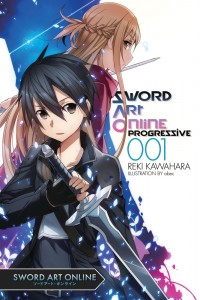By Reki Kawahara and abec. Released in Japan by ASCII Mediaworks. Released in North America by Yen On.
I’ve already discussed some of the ideas behind this concept in my review of the first manga, so I’ll try to skim over that and discuss what I enjoyed about SAO:P as a novel. Again, I don’t think it’s a sort of ‘reboot’ where you can read it in place of the original – I think knowing the characters already adds to the depth. But the main reason to read this is to see how Kawahara develops Aincrad, a world he introduced and essentially abandoned in the first book, sequels and side stories aside. And we also get the addition of Asuna’s POV narration, though sadly only for part of the first arc, after which it’s back to all Kirito all the time.
Despite this, Asuna benefits enormously from the added face time. We see her at the start, having essentially decided that she wants to attempt to die with dignity, or at least on her own terms, something that Kirito is able to talk her out of. As the book goes on (and it is a BIG book – at 360 pages, almost as big as Fairy Dance put together) and Asuna starts to actually pay attention to the rules of the game and how to succeed, she becomes just as good if not better than Kirito – the skills she’s used her entire life as a girl who has to be in the top of the class for everything now benefit her in the RPG environment, and she also has more socialization than Kirito, meaning she can see people in a way that he’s unable to – this really becomes apparent in the second half of the book, where Kirito has pegged himself as an evil person, and Asuna has to side-eye him several times and go “really?”. Kirito, meanwhile sees potential in Asuna, and wants her to be the role model for the game world that he feels unworthy of being himself. They’re not a couple here, but you definitely see why they’re perfect for each other – they’re both quite similar, and their differences complement each other.
There’s no Klein, Lisbeth or Silica here, and Agil is mostly just support. The new addition is Argo, though she’ll be familiar to fans of the anime. She doesn’t vanish after the first few pages, however, and actually gets to show off some character depth and an awesome ‘to the rescue’ bit. In addition, the “Interlude” focusing on her and Kirito is hilarious, the second funniest part of the book. (The funniest part of the book involves Asuna’s inventory and Kirito’s complete ignorance of a maiden’s true heart, as well as measuring rage in gravitational units – I’ll leave it at that.)
The most interesting part of the book takes place right at the end, where a scheme is uncovered that led indirectly to the death of a player (or so they hear), and the concept of PKing comes up for the first time, this time as capital punishment. When does justice become vigilante justice? Kirito has definite views on the subject, but he’s already burned so many bridges (or at least he thinks he has) that he doesn’t want to make any rallying speeches. Luckily, things defuse before we can go there, but everyone is now thinking about it. We’re not at Laughing Coffin just yet, but the seed has been planted.
This book covers the first two floors of Aincrad, and the afterword says there should be 2 floors per novel, so things will likely continue to move quite slowly. This is the main goal of this series, of course, and I’m greatly enjoying what it’s trying to do. And of course there’s also an additional bonus – this is 8 years after the author first wrote SAO, and his prose has improved a great deal. Sword Art Online fans will love this. (Also, I appreciate that ‘Kuroko’ was likely impossible to translate without a footnote, but ‘Blackie’? Geh.)


Speak Your Mind